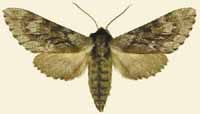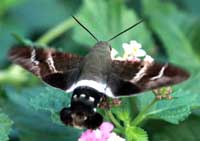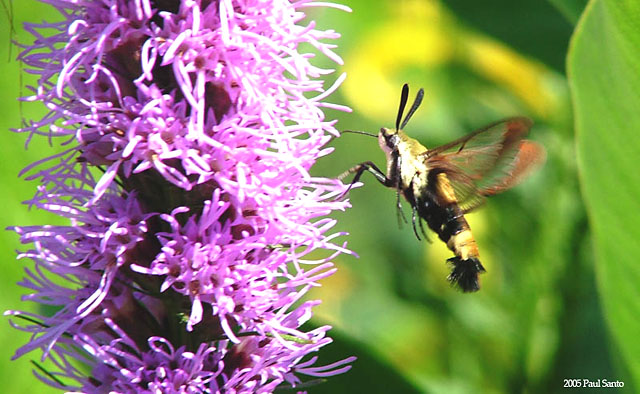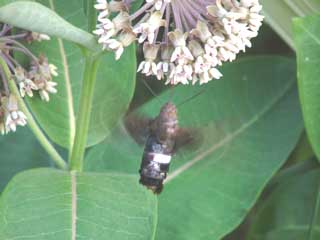Sphinginae subfamily
Sphingini tribe:
 |
Ceratomia amyntor
WO/NV,
the Elm Sphinx or Four-horned Sphinx
The upperside of the forewing is brown with dark brown and white
markings including a white costal area near the wing base, dark
streaks along the veins, and a white spot in the cell. The upperside
of the hindwing is light brown and has a dark brown band along the
outer margin.
|
Ceratomia amyntor larva, Stillwater, July 24, 2008, Nick Verette
 |
The upperside of the forewing is pale brownish gray with wavy black
and white lines and a black-outlined white cell spot. The upperside
of the hindwing is gray with diffuse darker bands.
|
 |
Reported from northern Minnesota and central western Wisconsin,
it might be present in Washington County. This is one we have on P.E.I.
|
 |
Manduca quinquemaculata
WO the Five-spotted Hawkmoth.
The moth abdomen usually has five but sometimes six pairs of yellow
bands. The upperside of the forewing is blurry brown and gray. The
upperside of the hindwing is banded with brown and white and has two
well-separated median zigzag bands.
|
 |
Sphinx chersis
WO, the Northern Ash Sphinx or Great Ash
SphinxThis species is recorded in nearby Ramsey County and should be present.
Larval hosts are ash, lilac, privet, cherry, and quaking aspen.
|
 |
This species is not officially recorded, but it may be present. We have
them on P.E.I., but I do not see them frequently. unlikely |
 |
If you have blueberries in the woods, then you might have the Poecila Sphinx.
They are pretty common here on Prince Edward Island, but don't fly
too far west of Wisconsin. |
Smerinthini Tribe:
 |
This moth is also fairly widely reported to the east and south
and might be present.
This is the first Sphinx species I reared as a boy in New Jersey.
See the file for the female; she is different. |
 |
This moth is found in Canada and states east, south and west of
Washington County, Minnesota,
so it is probably present in Washington Co., too. |
 |
Named for the dull grey-blue spot in the hindwing, this moth has a
wide distribution and is possibly present in Washington County.
I regularly see them on Prince Edward Island. |
 |
Named for the small eye-spot in the hindwing, this moth has a wide distribution
and is probably present in Washington County.
I regularly see them on Prince Edward Island, and they are reported
as far south as Florida.
|
 |
Reported in northern Minnesota, it might be present in Washington County also.
At my home in Montague, P.E.I., Canada, they are quite common. |
 |
This moth is widely distributed to the east, so it may be present
in Washington County.
Along the East Coast, it flies from P.E.I. to Florida. |
Macroglossinae subfamily
Dilophonotini tribe:
 |
The body is dark brown with a wide white stripe across the abdomen.
The wings are dark brown. The upperside of the hindwing has
pale patches along the costa and inner margin.
rare summer/fall stray |
Aellopos titan, July 4, 2006, Paul Santo.
 |
The abdomen has very distinct gray and black bands.
Adults nectar at dusk so you may see them in the garen at that time.
probably only as a stray
|
 |
Hemaris thysbe
WO, the Hummingbird Clearwing
This interesting day flier is not confirmed for Washington County.
They are widely distributed in the east from P.E.I. to Florida.
|
 |
Hemaris diffinis
PS, the Snowberry Clearwing or Bumblebee
Moth
This moth is widely distributed and is confirmed by Paul Santo
for Washington County.
|
Hemaris diffinis, July, 2005, Washington County, Paul Santo.
Macroglossini tribe:
 |
Darapsa myron
WO, the Virginia Creeper Sphinx or the
Grapevine Sphinx
The forewing upperside is dark brown to pale yellowish gray, with an
olive tint.
On the costal margin there is a dark rectangular patch, although this
may be reduced or absent. The upperside of the hindwing is pale
orange.
|
 |
Hyles gallii WO, the Bedstraw Hawk Moth
or Gallium Sphinx
This species is not reported in Minnesota, but I expect it is present.
Some years I see them on P.E.I., some years, I do not.
|
 |
Hyles lineata
WO, the White-lined Sphinx
This species is recorded in nearby Ramsey County.
It is a strong migrator from the south,
and there are records from the east and from the west. |
|
|


